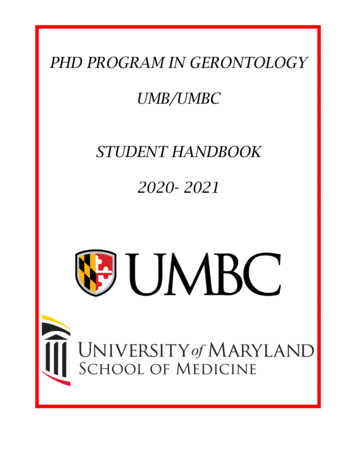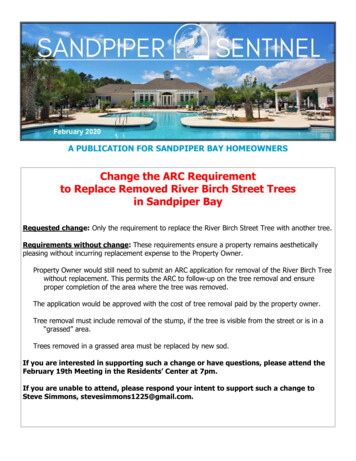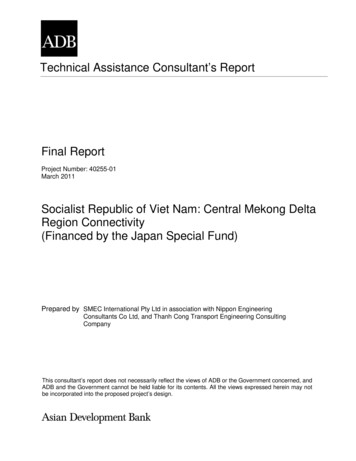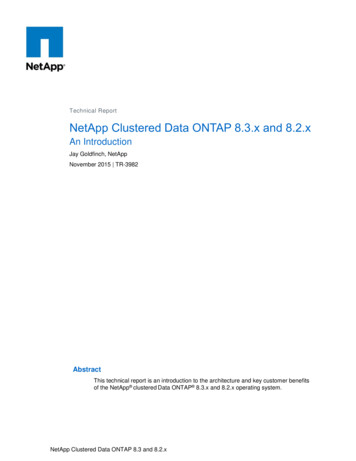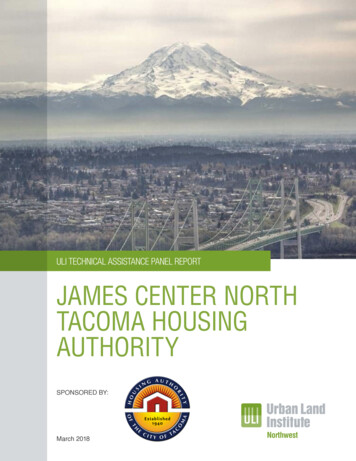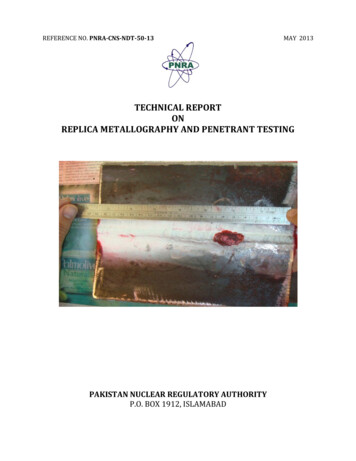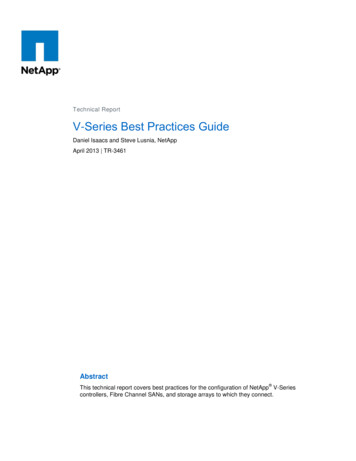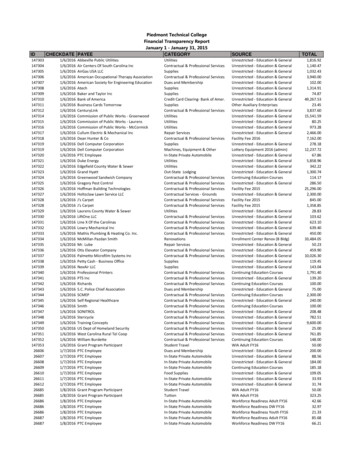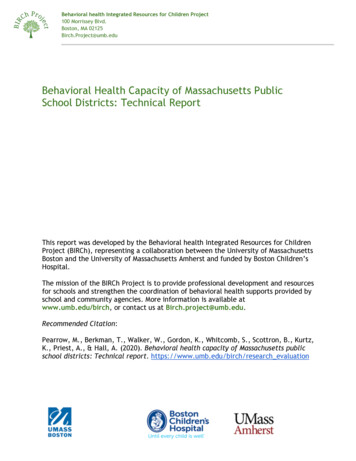
Transcription
Behavioral health Integrated Resources for Children Project100 Morrissey Blvd.Boston, MA 02125Birch.Project@umb.eduBehavioral Health Capacity of Massachusetts PublicSchool Districts: Technical ReportThis report was developed by the Behavioral health Integrated Resources for ChildrenProject (BIRCh), representing a collaboration between the University of MassachusettsBoston and the University of Massachusetts Amherst and funded by Boston Children’sHospital.The mission of the BIRCh Project is to provide professional development and resourcesfor schools and strengthen the coordination of behavioral health supports provided byschool and community agencies. More information is available atwww.umb.edu/birch, or contact us at Birch.project@umb.edu.Recommended Citation:Pearrow, M., Berkman, T., Walker, W., Gordon, K., Whitcomb, S., Scottron, B., Kurtz,K., Priest, A., & Hall, A. (2020). Behavioral health capacity of Massachusetts publicschool districts: Technical report. https://www.umb.edu/birch/research evaluation
Behavioral Health Integrated Resources for Children Project100 Morrissey Blvd.Boston, MA 02125Birch.Project@umb.eduExecutive SummaryAccess to critical school-based behavioral health services varies significantly acrossthe state of Massachusetts. A central goal of the BIRCh Project is to increase thecapacity of schools to promote and integrate behavioral health services.Understanding current behavioral health supports available to school districts acrossthe Commonwealth is crucial to this mission. This technical report summarizesfindings from the first phase of an ongoing resource mapping project focused onworkforce capacity, state-funded grants, and Educational Collaborative membership.Students in Massachusetts lack adequate access to school-based behavioral healthstaff according to national recommended ratios. Moreover, school districts servingstudents with high economic needs have less access to school-based behavioral healthprofessionals, particularly Social Workers and School Psychologists. Priorities of the 25Educational Collaboratives across the Commonwealth include sharing resources toprovide direct services to students, professional development, technical assistance,and programs and services to improve district operations. Resource mapping suggeststhat 26.9% of identified high needs districts do not belong to a Collaborative, andthere are no Collaboratives servicing the most western part of the state. Additionally,34.6% of the school districts with high economic need and disproportionately lowstaffing of school-based behavioral health professionals did not access anyDepartment of Elementary and Secondary Education (DESE) behavioral healthgrants.Stakeholders representing state agencies, district administrators, EducationalCollaboratives, school-based and community-based providers, and university trainersnoted fragmented access across geographic regions and limited coordination ofresources. The fragmented allocation of behavioral health resources reflects the lackof a state-driven coordinated plan for school-based prevention efforts. Withoutdesignated district leadership to focus on these efforts and with competing districtlevel priorities, schools and districts have limited access to quality and sustainableschool-based behavioral health programming.Our hope is that the current findings serve as a foundation to strengthen thecoordination of behavioral health services available through school, community, andstate agencies. The report offers strategies to address gaps in access to mental healthservices so that all students can benefit from high-quality services that emphasizeprevention and promote positive education and life outcomes. It offers policyrecommendations organized around the following five areas: Consistent andCoordinated Professional Development; Workforce Development Opportunities;Supportive and Collaborative Partnerships; Incentivizing Collaboratives; and,Regional Technical Assistance Centers.Background2
Behavioral Health Integrated Resources for Children Project100 Morrissey Blvd.Boston, MA 02125Birch.Project@umb.eduThe behavioral and mental health needs of children have been called a ‘silentepidemic’ with grave implications for families and communities (Anderson & Cardoza,2016). Despite the estimate that 20% of U.S. children meet criteria for behavioralhealth disorders, our nation’s response continues to fall short with the vastmajority (80%) of children identified as in need of services receiving nointervention (Caldarella et al. 2008; Kataoka, Zhang, & Wells, 2002; Perou et al.,2013). Among children who do access services, schools played an integral role(Farmer, Burns, Philip, Angold, & Costello,2003; Merikangas, He, Burstein, Swendsen,Avenevoli, Case, Georgiades, Heaton,Swanson, & Olfson, 2011). The school settingis a convenient location that reduces a varietyof access barriers (Blake, Ledsky, Goodenow,& O’Donnell, 2001; Durlak, Weissberg,Dymnicki, Taylor, & Schellinger, 2011). Yet,even within the context of school settings,access to needed behavioral health servicesvaries tremendously across geographicregions, states, and local communities.The minimum standard for school-basedservices is established and enforced by thefederal government (e.g., IDEIA), though the bulk of responsibility for ensuring qualityeducation services is carried out at the state and local levels. State agencies maintainoversight of qualifications and licensing of professional staff; still, states delegatemuch of the authority for the management of public schools to local educationagencies (LEA; Jacob, Decker, & Hartshorne, 2010). As such, the responsibility of staffappointments, employment expectations, and professional role configurations fall onlocal districts and leadership. Within these complex layers of governmental oversight,there remain tremendous gaps in access to school-based mental health services acrossstates, as well as within states across local communities.Throughout the Commonwealth, schools often struggle to effectively implement acontinuum of student support initiatives that promote healthy development andaddress mental health needs of students. Numerous overlapping agencies support thedevelopment of the whole child, yet some of our most vulnerable children experiencelimited access to services due to fragmented organizational systems. Even thoughMassachusetts is the leader in academic achievement, the lack of integratedbehavioral health services results in vast disparities and a failure to address thedemonstrated needs of children.3
Behavioral Health Integrated Resources for Children Project100 Morrissey Blvd.Boston, MA 02125Birch.Project@umb.eduOur hope is that the findings presented in this report serve as a foundation tostrengthen the coordination of behavioral health services available through school,community, and state agencies. It merges findings from multiple data sources tobetter understand the disparities across the Commonwealth, and offers strategies andpolicy recommendations for more equitable access to school behavioral healthservices.Purpose of Current ReportWith the overarching goal of understanding the capacity of school districts inMassachusetts to address the behavioral health needs of students, the goals of thecurrent project were threefold. First, the research team examined students’ access tolicensed Professional Support Personnel (e.g., school psychologists, school socialworkers, school counselors, school nurses), as reported by the Department ofElementary and Secondary Education (DESE). Student-to-staff ratios were calculatedand then compared to the recommendations of each national, professional andcredentialing organization. These findings on the current capacity were thencompared across school districts, with a focus on equitable access based on studenteconomic need.In addition to sufficient staffing levels, schools anddistricts need access to high quality professionaldevelopment and support to provide comprehensiveschool-based services. The second aspect of the studywas to examine the dissemination of state educationresources - specifically competitive funding to supportsocial, emotional, and behavioral health. As such, grantsprovided by DESE to schools and districts that targetedstudents' social, emotional, mental, and behavioralhealth were explored.Finally, this report highlights findings from state and community leaders and otherexperts, in the field of behavioral health, on the variability of districts’ capacity through staffing, professional development, and grants - to meet the behavioralhealth needs of students. In these interviews, factors that contribute to communities’access to services, and the impact of overlapping and competing priorities at thebuilding, district, and state level were explored.Procedures for the three studies, more specifically methodology, analysis procedures,and findings, are described in depth in the sections below. The consolidation offindings, strategies to ameliorate inequities, and policy recommendations for moreequitable access to school behavioral health services are outlined in the final sectionof the report.4
Behavioral Health Integrated Resources for Children Project100 Morrissey Blvd.Boston, MA 02125Birch.Project@umb.eduStaffing Ratios & Student Economic NeedSchool-based behavioral health workforce was evaluated using publicly available datafrom DESE for the 2018-19 school year. The four fields credentialed through DESE asProfessional Support Personnel licenses are as follows: SchoolSchoolSchoolSchoolCounselor (Levels: PreK-8; 5-12)Social Worker/School Adjustment Counselor (All Levels)Psychologist (All Levels)Nurse (All Levels)Requirements for these professional licenses include graduate courseworkaccompanied by supervised field experiences and demonstrated competencies in theimplementation of social, emotional, and behavioral health and/or health services.Only those employed by the local education agencies (LEAs) were included in theanalysis.The number of students in each LEA was also examined, including the percentage ofstudents identified as economically disadvantaged. “Economically disadvantagedstudents” are defined by DESE as those who participate in one or more of thefollowing state-administered programs: the Supplemental Nutrition AssistanceProgram (SNAP); the Transitional Assistance for Families with Dependent Children(TAFDC); the Department of Children and Families (DCF) foster care program; andeligible MassHealth program (Medicaid).These data were calculated to determine staff-to-student ratios for each of theprofessional licenses. Staffing ratios of districts were organized into quartiles.Similarly, districts with the highest concentrations of economically disadvantagedstudents were organized into quartiles. Data were combined to identify districts withthe highest economic need and poorest staffing ratios. These districts were thenmapped using ArcGIS software and geospatial data available through MassGIS1.FindingsDuring the 2018-2019 school year, the 406 public school districts employed 7,475Professional Support Personnel in schools to meet the needs of 951,631 students.2,048 school nurses provide a range of health services, and the remaining 5,4271MassGIS, Bureau of Geographic Information, Commonwealth of Massachusetts EOTSS; school-district data waslast updated in June 20195
Behavioral Health Integrated Resources for Children Project100 Morrissey Blvd.Boston, MA 02125Birch.Project@umb.edusupport personnel provide school-based counseling, academic guidance, health, andbehavioral health services.Overall, when compared to the staff-to-student ratios recommended by nationalassociations from each of the professional fields, Massachusetts public schools arecurrently under resourced in the specializations of School Social Worker/AdjustmentCounselor, School Counselor, and School Psychologist. Students in Massachusettspublic schools have adequate access to services provided by School Nurses (see Table1).Table 1. Massachusetts Staff-to-student ratiosProfessional SupportPersonnel LicenseNumber ofProfessionalsin MA SchoolsRatio ofStaff:StudentNationalRecommendedRatiosSchool Social Worker/ SchoolAdjustment Counselor17771:5361:250School Counselor23531:4041:250School Psychologist12971:7341:500School Nurse20481:4651:750Access to each of the Professional Support Personnel was organized into quartiles,based on the percentage of economically disadvantaged students, as defined above.These results were also compared to the nationally recommended ratios. Findingsindicate that across all quartiles, students have adequate access to School Nurses.Students with the greatest economic need had the least access for School Counselorsand School Psychologists, with twice the ratio between the lowest and highestquartile for access to School Psychologists. Students with the least economic need hadthe most limited access to School Adjustment Counselors/School Social Workers. Thefindings are demonstrated in Figure 1.6
Behavioral Health Integrated Resources for Children Project100 Morrissey Blvd.Boston, MA 02125Birch.Project@umb.eduFigure 1. Staffing Ratios of Student Support Personnel in Massachusetts SchoolDistricts According to Economic Need of Students7
Behavioral Health Integrated Resources for Children Project100 Morrissey Blvd.Boston, MA 02125Birch.Project@umb.edu*School Social Worker/School Adjustment CounselorTwenty-six Massachusetts school districts were identified as having both the highestlevel of student economic need and poorest staffing ratios (see Figure 2). Thesedistricts span every geographic region and county in Massachusetts (with theexception of Dukes, Nantucket, and Norfolk counties). Districts near urban centersand in rural towns are overrepresented among districts with high economic need,and 54% of these districts are recognized as “Gateway Cities.” Among thesedistricts, the proportion of Hispanic students in high needs districts is 11.4% higherthan the state average and the proportion of students who speak a first languageother than English is 7.2% higher than the state average.Figure 2. Map of High Needs Districts8
Behavioral Health Integrated Resources for Children Project100 Morrissey Blvd.Boston, MA 02125Birch.Project@umb.eduTable 2. List of High Needs Districts in MAHigh Needs AttleboroHaverhillWareLynnNorth nomoyLawrenceAyer-ShirleyFall RiverSpringfieldOrangeNarragansettMaldenSouth HadleyThese findings suggest that students throughout the Commonwealth lack adequateaccess to school behavioral health staff - School Social Workers/ School AdjustmentCounselors, School Psychologists, and School Counselors - based on nationalrecommendations. Additionally, there is great variability in access to behavioralhealth supports and corresponding staff positions based on the level of studenteconomic need, particularly in regard to Social Workers and School Psychologists.School districts serving students with high economic need disproportionately facebarriers in access to quality behavioral health service delivery.9
Behavioral Health Integrated Resources for Children Project100 Morrissey Blvd.Boston, MA 02125Birch.Project@umb.eduState and Regional Resource MapsThe second aspect of the study was to examine the dissemination of state resources specifically competitive funding to support social, emotional, and behavioral health.As such, grants provided by DESE to schools and districts were explored. Grantresources included the Safe and Supportive Schools Programs (SaSS) and ImprovingStudent Access to Behavioral and Mental Health Services. Multi-year training andsupport, also sponsored by DESE, included PBIS Academy grant, in partnership withthe University of Connecticut Center for Behavioral Education and Research; SystemicStudent Support Academy (S3) grant, in partnership with Boston College’s Center forOptimized Student Support and the Rennie Center for Education and Research Policy;and, the SEL/MH Academy grant, in partnership with the Education DevelopmentCenter and Transforming Education. Grant program descriptions are summarizedbelow (Table 3).Table 3. DESE Grant Program DescriptionsGrantNameSafe ears Mapped2017-2020Grant PurposePurpose is to organize, integrate, and sustain school and district-wideefforts to create safe and supportive school environments. Schools thatreceive funding through their district in this program will either convene aschool team and use the Safe and Supportive Schools Self-AssessmentTool, determine areas to prioritize for improvement and finalize an actionplan, or implement and assess progress on a previously created actionplan. Grants last one year, and continuation funding is available.More information can be found ngStudentAccess toBehavioraland MentalHealthServicesDESE2019-20Purpose is to improve student behavioral and mental health outcomes andto address related barriers to student success. Goals include to developcomprehensive, integrated multi-tiered systems for student support andestablish an infrastructure to facilitate integrated coordination of schooland community-based resources. Projects are prioritized that forgepartnerships and increase access between schools and communityorganizations. Grants last two years.More information can be found demyDESE &University ofConnecticutCenter forEducation andResearch2013-2020Purpose is to support district and school-based teams to implement PBIS.Academy includes training and networking opportunities, as well as on-sitetechnical assistance and consultation. The grant program lasts threeyears. This program focuses on Tier 1 implementation, while some schoolsmay qualify to participate in a Tier 2 Academy. Grants last three years.More information can be found at: http://www.doe.mass.edu/sfss/profdev/?section pbis10
Behavioral Health Integrated Resources for Children Project100 Morrissey Blvd.Boston, MA ademy(S3)DESE & BostonCollege’sCenter forOptimizedStudentSupport &Rennie Centerfor Educationand ResearchPolicy2018-2020SEL/MHAcademyDESE &EducationDevelopmentCenter &TransformingEducation2019-2020Purpose is to support district-level teams in implementing integratedsystems of student support. The S3 Academy is structured around a seriesof in-person workshops and supplemental webinars. This grant programlasts one year.More information can be found at: http://www.doe.mass.edu/sfss/profdev/?section s3#accordionPurpose is to help districts integrate SEL and mental health within an MTSSframework and align the work with existing priorities, systems, andpractices. This program includes 3 years of professional development,coaching, networking, and technical assistance.More information can be found at: http://www.doe.mass.edu/sfss/profdev/?section sel#accordionEducational CollaborativesIn addition to the DESE funded grant programs, under Massachusetts law (M.G.L.Chapter 40, Section 4E), local school committees can join together to developEducational Collaboratives with the goals of jointly delivering services to buildcapacity and decrease the financial burden on individual school districts. Priorities ofEducational Collaboratives include sharing resources to provide direct educationalservices to students (e.g., special education services), professional development,technical assistance, and programs and services to improve district operations.Collaboratives must be approved by all participating school committees, as well as byDESE. Collaboratives must report annually to the DESE on their 1) programs andservices provided, 2) cost effectiveness of the services being provided as acollaborative as compared to the services being provide
mapped using ArcGIS software and geospatial data available through MassGIS1. Findings During the 2018-2019 school year, the 406 public school districts employed 7,475 Professional Support Personnel in schools to meet the needs of 951,631 students. 2,048 school nurses provide a range of health services, and the remaining 5,427
